The Predictive Value of Geriatric Nutritional Risk Index Combined with the GRACE Score in Predicting the Risk of One Year Poor Prognosis in Elderly Patients with Non-ST Segment Elevation Myocardial Infarction After PCI
IF 3.7
3区 医学
引用次数: 0
Abstract
Background: As a nutritional indicator, a lower level of geriatric nutritional risk index (GNRI) has been suggested as a predictor for poor prognosis in acute coronary syndrome (ACS). However, whether GNRI could improve the predictive value of the Global Registry of Acute Coronary Events (GRACE) score for the prognosis in elderly patients with non-ST segment elevation myocardial infarction (NSTEMI) after PCI remains unclear.Methods: A total of 446 elderly patients with NSTEMI after percutaneous coronary intervention (PCI) were consecutively enrolled. Patients were divided into major adverse cardiovascular and cerebrovascular events (MACCE) group and control group according to the occurrence of MACCE during one year follow up. The clinical parameters including GNRI were compared to investigate the predictors for MACCE. The performance after the addition of GNRI to the GRACE score for predicting MACCE was determined.
Results: A total of 68 patients developed MACCE. In unadjusted analyses, the rate of MACCE was significantly higher in the 93.8
老年营养风险指数与 GRACE 评分相结合对预测 PCI 后非 ST 段抬高心肌梗死老年患者一年不良预后风险的预测价值
背景:作为一项营养指标,较低水平的老年营养风险指数(GNRI)被认为是预测急性冠状动脉综合征(ACS)不良预后的一个指标。然而,GNRI 是否能提高全球急性冠脉事件登记(GRACE)评分对PCI 后非 ST 段抬高型心肌梗死(NSTEMI)老年患者预后的预测价值仍不清楚:共有 446 名经皮冠状动脉介入治疗(PCI)后 NSTEMI 老年患者连续入选。根据随访一年期间发生主要心脑血管不良事件(MACCE)的情况,将患者分为主要心脑血管不良事件组和对照组。通过比较包括 GNRI 在内的临床参数,研究 MACCE 的预测因素。结果显示,在 GRACE 评分中加入 GNRI 后,预测 MACCE 的效果更佳:结果:共有 68 名患者发生了 MACCE。在未经调整的分析中,93.8分的MACCE发生率明显更高:结合 GNRI 和 GRACE 评分可显著提高老年 NSTEMI 患者 PCI 术后一年 MACCE 的预测价值。通过使用这种新的联合风险模型,我们可以在临床实践中轻松识别高危人群,从而更好地对其进行监测和管理。
本文章由计算机程序翻译,如有差异,请以英文原文为准。
求助全文
约1分钟内获得全文
求助全文
来源期刊

Clinical Interventions in Aging
GERIATRICS & GERONTOLOGY-
CiteScore
6.20
自引率
2.80%
发文量
193
期刊介绍:
Clinical Interventions in Aging, is an online, peer reviewed, open access journal focusing on concise rapid reporting of original research and reviews in aging. Special attention will be given to papers reporting on actual or potential clinical applications leading to improved prevention or treatment of disease or a greater understanding of pathological processes that result from maladaptive changes in the body associated with aging. This journal is directed at a wide array of scientists, engineers, pharmacists, pharmacologists and clinical specialists wishing to maintain an up to date knowledge of this exciting and emerging field.
 求助内容:
求助内容: 应助结果提醒方式:
应助结果提醒方式:


